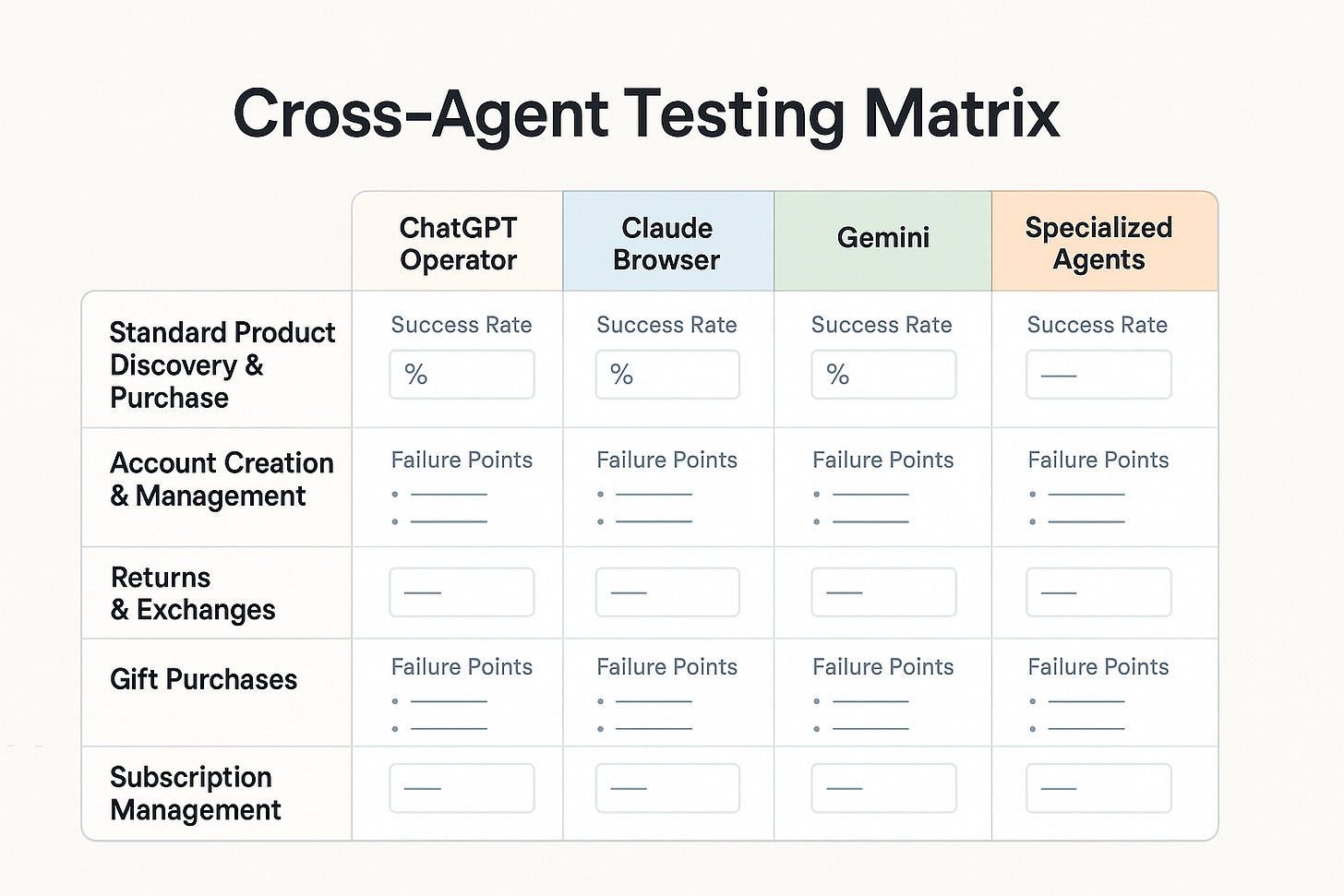Cross-Agent Testing: The New Essential for Retail Success
It's July 2025, and you're looking at your traffic analytics. Agent traffic was 1% in April. Now it's 10% in July. And something troubling is happening—your conversion rate for this traffic is significantly lower than for human shoppers.
Welcome to the new reality of retail. Just as we once obsessed over cross-browser testing to ensure our sites worked flawlessly for users on Chrome, Firefox, and Safari, we now face a similar inflection point with AI shopping agents.
Why Cross-Agent Testing Matters Now
For the past 15-20 years, your testing protocols have been designed around human behavior. You've optimized for human eyes, human patience levels, and human decision-making processes. But AI agents navigate your site completely differently.
When an AI agent like ChatGPT's operator browses your site, it's taking screenshots, analyzing them through its model, and determining what to click next. This process creates fundamentally different interaction patterns than human browsing.
The consequences of ignoring these differences are already showing up in early adopter data. We're seeing conversion rates for agent traffic that can be 40-60% lower than for humans—even when those agents have clear purchase intent from their users.
What Makes Cross-Agent Testing Different
Cross-agent testing isn't just cross-browser testing with a new name. There are critical differences:
1. Journey-Based Testing
While browser testing focuses on rendering and functionality, agent testing must verify complete user journeys—from initial product discovery to final checkout confirmation.
For example, can an agent successfully:
Find the right product based on specific user requirements
Navigate your filtering system to narrow options
Add items to cart
Apply promotional codes
Complete checkout with different payment methods
Each of these steps presents unique challenges for AI agents that humans don't face.
2. Varied Agent Behavior
Not all AI agents behave the same way. ChatGPT's operator approaches your site differently than Claude or Gemini. Specialized shopping agents have their own behaviors and capabilities.
Your testing matrix needs to account for these differences, just as you once accounted for how Safari rendered CSS differently than Chrome.
3. Rapidly Evolving Capabilities
Browser capabilities evolved on predictable release cycles. AI agent capabilities are improving weekly, sometimes daily. Your testing approach needs to keep pace with this rapid evolution.
How to Implement Cross-Agent Testing
Here's how to build cross-agent testing into your development process:
1. Map Your Critical Journeys
Start by identifying the most common shopping journeys on your site:
Standard product discovery and purchase
Account creation and management
Returns and exchanges
Gift purchases
Subscription management
For each journey, document the exact steps a human would take to complete it.
2. Test with Multiple Agents
Run tests across multiple AI shopping agents:
ChatGPT's operator
Claude's browser capabilities
Gemini
Emerging specialized shopping agents
Document the success rates and failure points for each agent on each journey.
3. Identify Common Failure Points
Look for patterns in where agents struggle:
Complex forms
Multi-step processes
Interactive elements like sliders or date pickers
Dynamic content loading
CAPTCHA and security measures
These pain points will become your priority areas for optimization.
4. Integrate with Your Development Pipeline
Just as you've embedded cross-browser testing into your CICD pipeline, cross-agent testing should become a standard step in your development and deployment process:
Development stage: Developers run basic agent tests on new features
Testing stage: QA conducts comprehensive agent testing across journeys
Staging: Final verification with production-like data
Production: Ongoing monitoring of agent performance
Make agent testing a deployment gate—if an update breaks the agent experience, it doesn't go live.
5. Monitor and Adapt
As AI agents evolve, your testing approach must evolve too:
Retest regularly, even without site changes
Update test scripts as agent capabilities change
Benchmark against competitors' agent performance
Track the correlation between agent success rates and revenue
The Business Case for Cross-Agent Testing
If you're wondering whether this investment is justified, consider:
Revenue impact: With agent traffic growing exponentially, even small improvements in agent conversion rates translate to significant revenue.
Competitive advantage: Retailers who optimize first for agent shoppers will capture market share that may persist for years, just as we saw with early mobile optimization.
Reduced returns: Ensuring agents select the right products reduces costly returns and exchanges.
Customer satisfaction: When a customer delegates shopping to an agent and it fails, that frustration transfers to your brand.
Start Now, Not When It's Too Late
The time to implement cross-agent testing isn't when agent traffic hits 10% of your total—it's now, when you have the runway to identify and fix issues methodically.
The retailers winning in 2025 will be those who recognized this shift early and prioritized agent experience alongside human experience. They'll have higher conversion rates, lower customer acquisition costs, and stronger brand loyalty in the AI-assisted shopping era.
Cross-agent testing isn't just a nice-to-have technical practice—it's a business imperative for retail success in the age of AI commerce.

